|
A Penny Saved is a
Penny Earned
by Bob Brooke
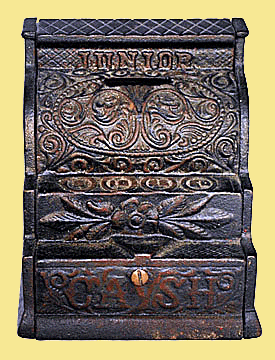 Many
people like cast-iron banks. Small banks often display them by their
teller windows. And while many of these are reproductions, the real ones
are just as fascinating to collectors. Perhaps it’s because they recall
America’s heritage, but more likely because they’re cute in a clunky
sort of way. Many
people like cast-iron banks. Small banks often display them by their
teller windows. And while many of these are reproductions, the real ones
are just as fascinating to collectors. Perhaps it’s because they recall
America’s heritage, but more likely because they’re cute in a clunky
sort of way.
Collectors have sought after old mechanical banks for over 50 years
because of their nostalgic look at America’s past reflected in the
interesting themes and animated action of these toy savings banks,
making them educational and timelessly wonderful objects.
Banks existed long before the 18th century, having already been in use
in 16th-century Europe. People referred to them as “boxes of potters
clay wherein one puts their money to keep.” Toy banks became popular in
the United States during the 18th century, when hard currency was
introduced.
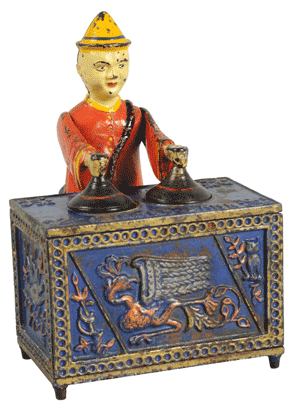 Mechanical
banks began to appear shortly after the end of the American Civil War
and the American public was eager to purchase them. At the time, a
severe coin shortage occurred because people saved them. In fact, the
situation got so bad that shopkeepers had to resort to using postage
stamps to make change. Both the Union and Confederate governments began
issuing paper notes to supplement their coinage and help relieve this
problem. But people didn’t like paper money because it could become
worthless quickly. Coins, on the other hand, would always retain the
value of their metallic content. Mechanical
banks began to appear shortly after the end of the American Civil War
and the American public was eager to purchase them. At the time, a
severe coin shortage occurred because people saved them. In fact, the
situation got so bad that shopkeepers had to resort to using postage
stamps to make change. Both the Union and Confederate governments began
issuing paper notes to supplement their coinage and help relieve this
problem. But people didn’t like paper money because it could become
worthless quickly. Coins, on the other hand, would always retain the
value of their metallic content.
So mechanical banks became a product of the times and their popularity
remained strong well into the 20th century. Not only were they fun toys,
but parents could effectively use them to teach their children the
practical aspects of being thrifty.
The range of mechanical banks is endless,
The Shepard Hardware Company of Buffalo, New York, was probably the
premier maker of cast-iron mechanical banks. Walter J. and Charles G.
Shepard founded their company to produce various pieces of hardware, but
in 1882, they began a sideline business making cast-iron mechanical
banks. Charles was an inventor.
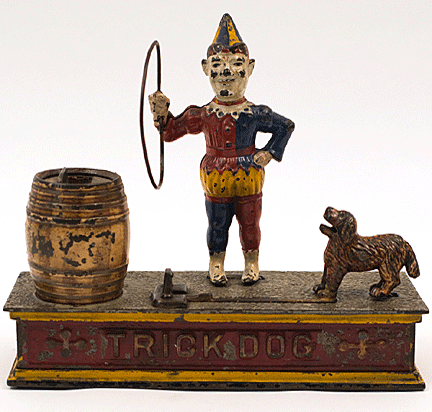
Shepard entered into the mechanical bank field in about 1882 and
available information indicates they sold out their line of toy banks in
1892. The impact Shepard had on the mechanical bank market was
astounding when you consider the fact they were able to design, patent,
produce, and effectively distribute 15 high quality banks within a time
span of only about 10 years.
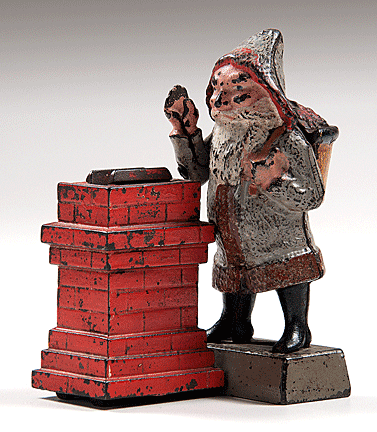 Their
banks sold for $1 each, but dealers could purchase them wholesale for
$8.50 a dozen, or about 70 cents each. Their
banks sold for $1 each, but dealers could purchase them wholesale for
$8.50 a dozen, or about 70 cents each.
All Shepard banks had these common features. First, their artistic paint
jobs were unsurpassed for attention to minute detail. Unfortunately, the
company didn’t use any primer coating to prepare the metal for painting,
so the paint eventually flaked off their banks.
Second, each Shepard bank has its name embossed on one of the casting
pieces. The name is generally in large bold letters located on the front
panel of the bank. Other cast-iron bank manufacturers didn’t put the
names of their banks on them. This resulted in many banks becoming known
by names other than the ones originally given to them by their makers.
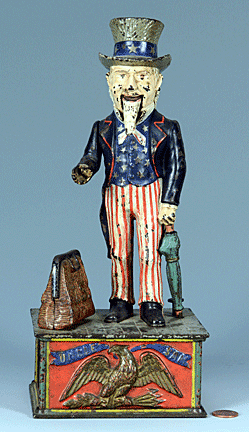 Third,
each Shepard cast-iron bank is very heavy for its size. It’s almost as
if cast iron was free and had no bearing on the production cost of the
items. Third,
each Shepard cast-iron bank is very heavy for its size. It’s almost as
if cast iron was free and had no bearing on the production cost of the
items.
In all, Shepard produced 15 different banks, including the Punch and
Judy Bank in 1884, the Trick Pony Bank, the Picture Gallery Bank, and
the Speaking Dog Bank, all from 1885. In 1886 they produced the Trick
Dog Bank and two years later the Circus Bank, followed by the Santa
Claus Bank in 1889, and the Artillery Bank in 1892. They have become
known for two in particular—the Uncle Sam Bank in 1886 and the Jonah and
the Whale Bank in 1890. Charles Shepard received a patent for the latter
bank on July 15, 1890. The overall length of the bank was 10-1/4 inches.
Shepard decorators painted the side and end plates of the base with
yellow corners, and the letters of the name in gold. They striped the
edges of the bottom plate and top part of the bank in yellow and black
and painted the water and waves realistically in light bluish-green with
white highlighting. The whale is a dark green-black color with a red
mouth and white teeth. The boat is an off shade of yellow with stripes
of gold, white, blue and red. The robes on the two figures are red and
blue, and they have white beards, flesh color faces and hands.
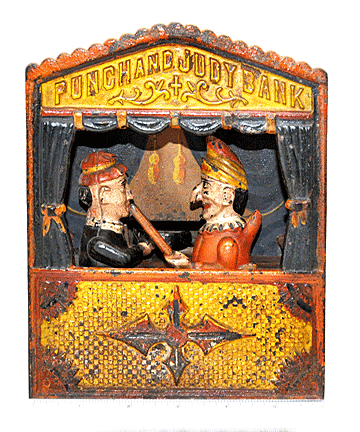 To
operate the bank, a person would place a coin on the back of the figure
of Jonah. Then the user would press a lever, recessed in the end plate
under the rear of the boat. As the whale opened his mouth wide, the
figure holding Jonah moved forward in the boat towards the whale. The
figure of Jonah tilted downward as though entering the whale's mouth,
but instead the coin flew off his back into the whale. Releasing the
lever returned the figures in the boat to their original position. The
whale’s mouth closed and re-opened as though swallowing the coin. The
whale’s lower jaw continued to move up and down for several seconds
after the action takes place. To remove the coins, the user would use a
key to unlock a trap in the underside of the base. To
operate the bank, a person would place a coin on the back of the figure
of Jonah. Then the user would press a lever, recessed in the end plate
under the rear of the boat. As the whale opened his mouth wide, the
figure holding Jonah moved forward in the boat towards the whale. The
figure of Jonah tilted downward as though entering the whale's mouth,
but instead the coin flew off his back into the whale. Releasing the
lever returned the figures in the boat to their original position. The
whale’s mouth closed and re-opened as though swallowing the coin. The
whale’s lower jaw continued to move up and down for several seconds
after the action takes place. To remove the coins, the user would use a
key to unlock a trap in the underside of the base.
Today, original Jonah and the Whale banks bring very high prices—if
they’re in mint condition. Unfortunately, most are not.
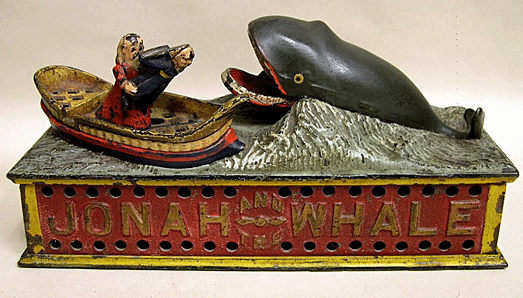
In 1892, Charles and Walter Shepard sold their cast-iron savings bank
business to J. & E. Stevens of Cromwell of Connecticut.
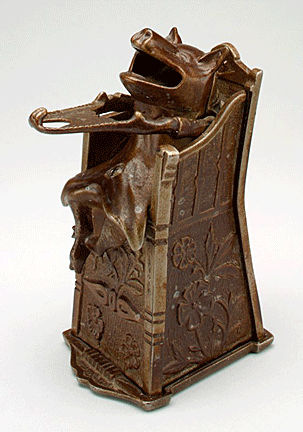 On
July 10, 1897, about 5 years after selling out their bank line to
Stevens, Charles Shepard and Peter Adams filed one last toy savings bank
patent application, which they received on August 24, 1897 for a
mechanical bank they called the Educated Pig Bank. On
July 10, 1897, about 5 years after selling out their bank line to
Stevens, Charles Shepard and Peter Adams filed one last toy savings bank
patent application, which they received on August 24, 1897 for a
mechanical bank they called the Educated Pig Bank.
This bank was the sole product of the J. & E. Stevens Company. Today,
it’s commonly known as the Pig in High Chair Bank, and it was a complete
departure from the other Shepard/Adams designs.
The bank was smaller than other Shepard models, except for possibly the
Santa Claus Bank. It was also lighter in weight than their previous
banks, had no identifying name embossed on any of its castings, utilized
the Stevens round coin trap, and was the only Shepard design to employ a
floral pattern.
J.&E. Stevens Co. of Cromwell, Connecticut, made similar banks through
the 1920s. Although more common than the Shepard models, Stevens'
Artillery Banks bring higher prices because of their colorful painted
decoration. One in mint condition sold for $22,000.
< Back
to Collectibles Archives
Next Article > |
